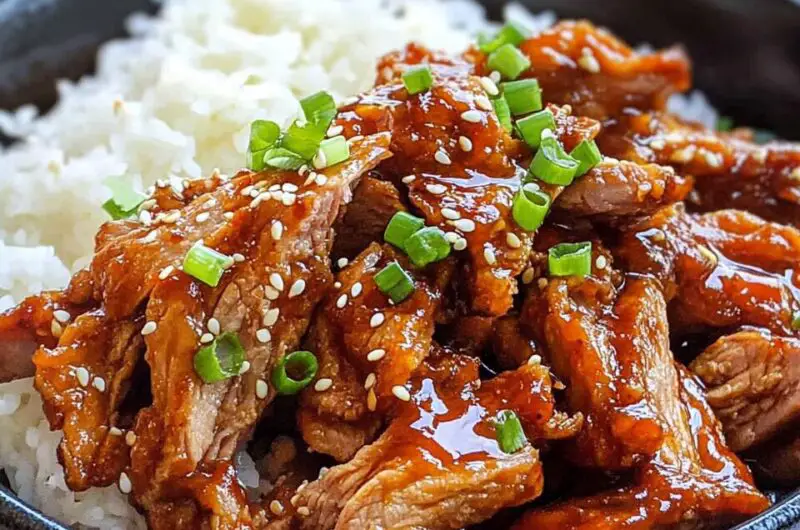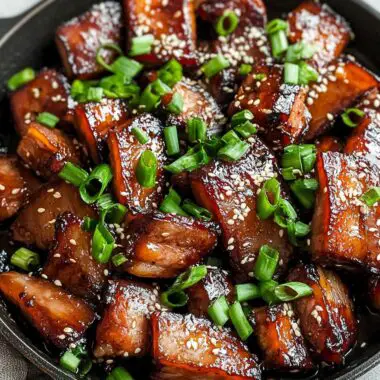The beauty of Korean BBQ Pork lies in its sweet, spicy, and savory harmony. The tender slices of pork shoulder soak up a marinade rich in gochujang, garlic, soy, and brown sugar, then get seared to a caramelized perfection. Each bite is bursting with bold flavor, perfectly complemented by a bowl of steaming white rice and crunchy cucumber slices. Whether you’re hosting a dinner gathering or meal prepping for the week, this dish is a delicious and easy win. With just 30 minutes of total cooking time, it’s ideal for busy weeknights yet fancy enough to impress at any dinner table. Add some kimchi on the side for a zesty punch, and you’ve got an unforgettable Korean-inspired feast.
Full Recipe:
Ingredients:
-
2 pounds pork shoulder, thinly sliced
-
1/2 cup soy sauce
-
1/4 cup brown sugar
-
2 tablespoons gochujang (Korean chili paste)
-
1 tablespoon sesame oil
-
1 tablespoon rice vinegar
-
4 cloves garlic, minced
-
1 tablespoon fresh ginger, grated
-
1/4 teaspoon black pepper
-
2 green onions, chopped
-
1 tablespoon sesame seeds
-
1 tablespoon vegetable oil (for searing)
-
Cooked white rice, for serving
-
Sliced cucumbers and kimchi, for garnish
Directions:
-
In a large bowl, whisk together the soy sauce, brown sugar, gochujang, sesame oil, rice vinegar, garlic, ginger, and black pepper.
-
Add the sliced pork to the marinade and mix well to ensure all pieces are coated. Cover and refrigerate for at least 1 hour, or overnight for deeper flavor.
-
Heat vegetable oil in a large skillet over medium-high heat. Add the marinated pork in batches to avoid overcrowding, and cook for 3-4 minutes per side or until the pork is caramelized and fully cooked.
-
Transfer cooked pork to a serving platter. Sprinkle with sesame seeds and green onions.
-
Serve hot with steamed rice, fresh cucumber slices, and kimchi on the side.
Prep Time: 15 minutes | Cooking Time: 15 minutes | Total Time: 30 minutes
Kcal: 410 kcal | Servings: 4 servings
Sweet and Spicy Korean BBQ Pork – A Deep Dive into Flavor
Korean BBQ Pork, or Dwaeji Bulgogi, is one of the crown jewels of Korean cuisine. Known for its bold, addictive flavor and juicy, caramelized texture, this dish is a go-to for weeknight dinners, festive gatherings, and Korean BBQ nights. Whether you’re new to Korean cooking or a seasoned home chef looking to add more cultural flavor to your kitchen, this dish offers the perfect balance of convenience, taste, and culinary artistry.
In this article, we’ll explore the history and origin of Korean BBQ pork, how to achieve restaurant-quality results at home, flavor-building techniques, ideal pairings, and how to adapt this dish for various dietary preferences. Plus, we’ll close with a reflection on why this dish belongs in your regular rotation.
The Origins of Korean BBQ Pork
While most people associate Korean BBQ with beef, pork has its own well-established place in the culinary traditions of Korea. Dwaeji Bulgogi (돼지 불고기) translates to “fire meat of pork,” and like its beef counterpart, it’s typically marinated before being grilled or pan-seared.
The marinade is where the magic happens. It’s a bold blend of gochujang (Korean fermented chili paste), soy sauce, garlic, sesame oil, and a sweetener like brown sugar or honey. This mixture not only tenderizes the pork but also imparts an unforgettable balance of heat, umami, and sweetness.
Pork has been a staple in Korean households for centuries due to its affordability and versatility. In the post-war years, pork became especially popular in Korean street food and family-style restaurants. Dwaeji Bulgogi became a communal dish often served sizzling hot, accompanied by rice, lettuce wraps, and an array of side dishes, or banchan.
Why Korean BBQ Pork Is So Addictive
The success of Korean BBQ pork lies in its layered flavors and textures. Here’s what makes it irresistible:
-
Sweet & Spicy Harmony: The gochujang-based marinade delivers a signature Korean flavor that hits all the notes salty, sweet, spicy, and slightly smoky.
-
Caramelization: Cooking the pork over high heat creates crispy edges and a deep, sticky glaze.
-
Juiciness: Pork shoulder or pork butt retains moisture during cooking, ensuring tender, flavorful bites.
-
Versatility: You can serve it as a rice bowl, in tacos, as lettuce wraps, or part of a BBQ spread.
Unlike Western BBQs that often focus on smoke and dry rubs, Korean BBQ brings a wet, fermented umami-forward experience. Gochujang adds not only heat but depth from fermented soybeans and glutinous rice, elevating this dish beyond a typical spicy pork stir-fry.
Cooking Tips for Perfect Korean BBQ Pork
Achieving authentic taste at home is easier than you think. The key lies in a well-balanced marinade and proper cooking technique.
-
Thin Slices: Thinly slicing the pork allows the marinade to penetrate deeply and cook quickly, ensuring even browning.
-
Marinate Overnight: If time allows, marinate the pork overnight. The longer the meat rests in the marinade, the deeper the flavor.
-
Cook in Batches: Overcrowding the pan leads to steaming rather than searing. Work in batches for the best caramelization.
-
Use Cast Iron or Grill: A hot surface ensures the sugars in the marinade caramelize, creating the signature Korean BBQ glaze.
For those without access to a grill, a cast-iron skillet or non-stick pan works perfectly fine. The most important factor is high heat and avoiding overcooking the pork.
Best Sides and Serving Ideas
Korean BBQ pork is wonderfully adaptable when it comes to presentation. Traditionally, it’s served with steamed rice, but the real joy is in the variety of side dishes (banchan) that bring color and texture to the plate. Here are a few ideas:
-
Kimchi: Fermented napa cabbage adds a tangy, spicy counterpoint.
-
Pickled Radish or Cucumber: Refreshing and cooling to balance the heat.
-
Lettuce Wraps (Ssam): Wrap a bit of pork in a lettuce leaf with rice, garlic, ssamjang (Korean dipping sauce), and eat in one bite.
-
Steamed Egg (Gyeran Jjim): A soft, savory egg custard that complements the bold pork flavor.
-
Japchae (Glass Noodles): Sweet potato starch noodles stir-fried with vegetables—perfect as a side.
This dish also lends itself to fusion ideas like Korean BBQ tacos, pork sliders, or even a spicy pork fried rice using leftovers.
Make It Your Own: Variations & Dietary Adjustments
Korean BBQ Pork is incredibly forgiving and customizable. Here’s how to tailor it:
-
Milder Version: Reduce or omit the gochujang if you’re sensitive to spice. Try sweet chili sauce for a gentler heat.
-
Sugar Alternatives: Use honey, maple syrup, or even grated pear for natural sweetness.
-
Vegan or Vegetarian: Substitute with sliced mushrooms, tofu, or tempeh using the same marinade.
-
Gluten-Free: Use tamari or coconut aminos instead of soy sauce, and ensure your gochujang is gluten-free.
-
Low Carb: Serve with cauliflower rice or over grilled vegetables.
The beauty of this recipe is that it can evolve with your preferences while maintaining its bold Korean essence.
Cultural Significance and Dining Experience
Eating Korean BBQ Pork isn’t just about nourishment it’s a cultural ritual. In Korean homes and restaurants, meals are often communal, encouraging sharing and interaction. Plating food on large platters and passing around sides adds a warm, family-style dynamic that brings people together.
It’s also an entry point into the broader world of Korean cuisine. Mastering dishes like Dwaeji Bulgogi builds confidence to explore other favorites like Bibimbap, Samgyeopsal, or Tteokbokki.
This dish beautifully captures the spirit of Korean culinary philosophy: balance, harmony, and respect for ingredients.
Conclusion:
Korean BBQ Pork is more than a spicy meat dish it’s a celebration of balance, flavor, and tradition. From its roots in Korean home cooking to its popularity in global food scenes, this dish has proven itself as a universal favorite.
Its ease of preparation makes it perfect for weeknight meals, yet its bold, exciting flavors make it just as suitable for entertaining guests or celebrating special occasions. With just a handful of pantry-friendly ingredients and some thoughtful technique, you can recreate an authentic Korean experience in your own kitchen.








